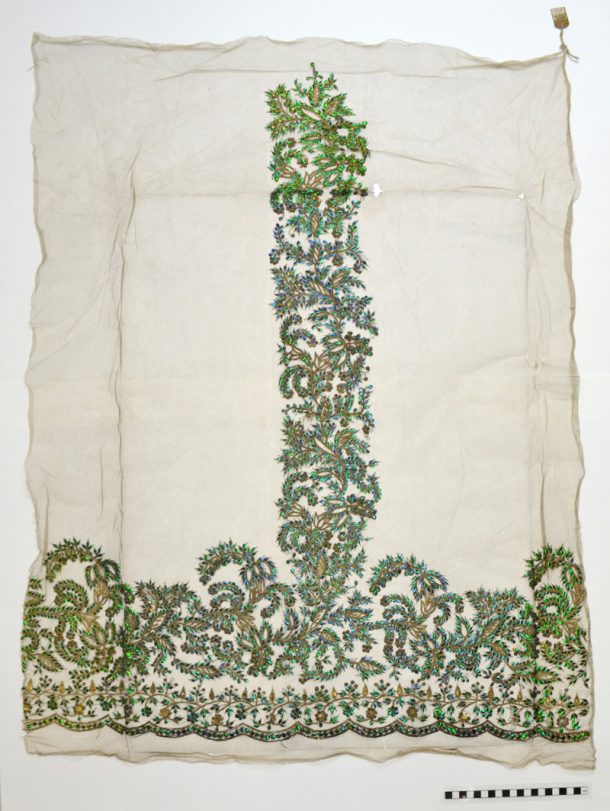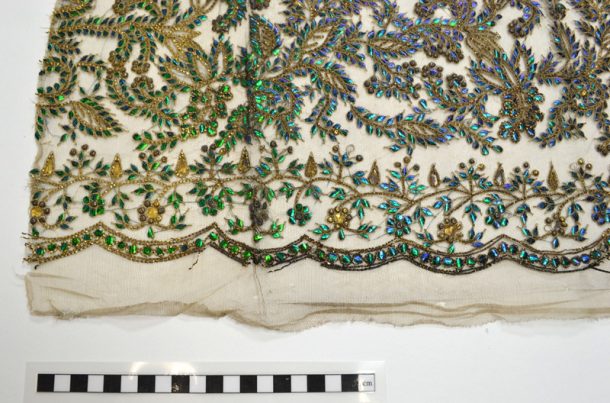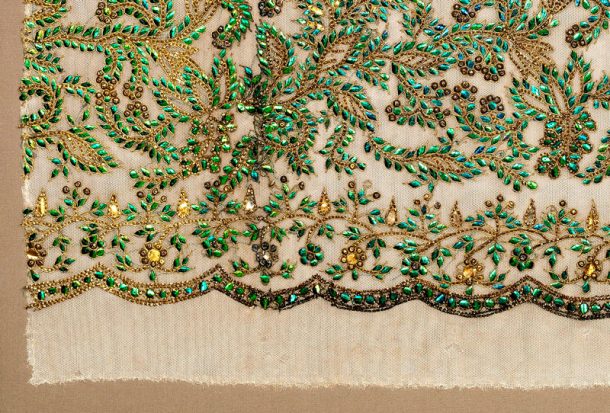by Lauren Osmond, MA Conservation student, Queen’s University, Kingston, Ontario
In the mid-nineteenth century, in India, the outer wing casings (elytra) of iridescent Jewel beetles were used to adorn metal embroidered textiles produced specifically for British export. The Victoria and Albert Museum owns many of these luxurious objects and continues to acquire them for its collections. In the summer of 2017, a skirt panel embellished with hand-cut beetle elytra (4411(IS), Figure 1) was conserved in preparation for display in the South Asia Galleries. This article outlines the condition of the object, the questions it raised, and the conservation work completed.

The skirt panel was made in 1858 in Hyderabad, India, out of a starched cotton bobbinet fabric with metal embroidery that is heavily embellished with elytra, cut into leaf and octagon shapes and sewn onto the net using indigo-dyed silk threads. The silver-gilt elements consist of two-ply threads made of flat thin silver strips (badla) wrapped around a starched silk core, braids made of two badla strips, dome-shaped sequins (katori), and sequins cut into teardrops (tikki) and circles. Hidden under the metalwork is a black block print outline that would have guided the embroiderer during production.
This fabric was designed with the intention of being made into a woman’s skirt. The skirt length originally consisted of five cotton net panels stitched together but is now in three separate fragments. After being transferred to the V&A from the India Museum in the UK in 1879, the skirt panel in question was likely unstitched and cut from the other panels in order to be framed for display in one of the Victorian wood cases once found in the V&A Textile Study galleries. There are no records of the object’s display but evidence can be seen on the skirt panel where a rectangular area of distortion about the size of the wood case frame is visible.
In addition to unravelling elements, overall museum dirt accumulation, hydrolysis, oxidation, tarnishing, staining, holes, and structural distortion, the most interesting degradation in this textile was in the elytra elements. The peripheral area of the skirt panel that would have been hidden behind the display frame, and thus blocked from light, is well preserved and appeared cleaner and more sparkly than the inner rectangular section of the skirt panel. In the former, the iridescence of the elytra boasts a vibrant emerald green, the original colour of the insect. In turn, the inner section where the textile was exposed to light and ultraviolet radiation had changed colour from green to a deep blue-violet with green “resist” lines where the dyed silk yarn had couched down the elytra to the net (Figure 2).

The iridescence and colour in this type of beetle, Buprestidae Julodinae Sternocera aequisignata, is structurally produced by many layers of chitin-protein fibres, meaning that this change in colour is the result of a structural change in the elytron microstructure. During examination, it was hypothesized that the structural change could be the result of dehydration causing the layers of chitin to collapse or delaminate, thus changing the way in which wavelengths of light are absorbed and diffracted. This sparked concerns about how the elytra would respond to the wet cleaning required to prepare this skirt panel for display. Consultation with Gill Comerford, preventative conservator, and Max Barclay, an entomologist both from the Natural History Museum (NHM) of London was pursued to inquire into this colour change phenomenon. It involved undertaking preliminary imaging techniques, such as scanning electron microscopy with energy dispersive X-ray analysis, which suggested minimal chemical changes and an overall friable structure. With no definite answers about the condition, we decided that the skirt panel would be selectively wet-cleaned on a suction table to offset any possible damage if water was to come into contact with the elytra.
The cotton net was first lightly surface cleaned and the tarnishing on the silver sequins was minimally reduced mechanically. To prevent further losses during handling and wet cleaning, all loose and already detaching elements were secured using Gütermann Skala 100% polyester thread. The suction table was lined with Bondina 30gsm, on top of which the textile was placed face-up with a protective layer over the embroidered areas. The textile was then covered with thin Melinex, leaving exposed 15cm2 sections for cleaning. In an effort to eliminate potential crushing of the metal and elytra sequins, Sympatex was used as the protective cushioning between the object and the Melinex to buffer the pressure caused by the sucking action of the table. It also doubled as a barrier that could control the potential wetting-out of the embroidered areas, if ever there was water infiltration.
Moving section by section with fresh blotting paper positioned between the object and the Bondina, the cotton net substrate was washed under a low suction using deionized water applied with a large mop brush, and then one application of Dehypon LS 54 suds and two applications of 1% Tri-sodium Citrate. The application of the detergent suds rather than the liquid solution allowed for more contact time with the textile under suction. Strips of blotting paper were positioned at the edges of the embroidery to absorb any water that could have been wicked under the Melinex and to control the development of tidelines. The net ground in the interstices of the embroidered areas was then cleaned using deionized water and a very small paint brush. Finally, the extreme tarnishing and accumulated dirt found on the metal areas along the fold lines was reduced by swabbing Industrial Methylated Spirits and lightly blotting with unbuffered blotting paper.
During washing, some water had accidentally wicked its way under the Melinex seal causing a few elytra to become wet. This resulted in a further change of colour from blue to a deep orange-red (Figure 3). Upon drying, the effected elytra turned back to blue. Finally, after significant rinsing and allowing suction to eliminate as much water as possible, the textile was blocked out, given a full Stablitex lining support, and then stitched to a grey fabric covered padded board.

Even though the elytra had been protected from the wet cleaning process, there was a visible shift of the colour of the elytra post-treatment (Figures 4 and 5). Many of the interior blue sequins had reverted back to a green or blue-green similar to the original emerald colour. These post-cleaning observations added new questions about the mechanisms causing colour changes. Were post-cleaning changes caused by the suction pulling the layers of chitin back together, or from humidity that swelled the chitin-protein matrix during washing?


The NHM specialists who performed a preliminary analysis of the object suggested research should be undertaken into its ‘resist’ pattern. Though a handful of textiles embellished with beetle elytra have been successfully washed at the V&A, the condition and behaviour of the elytra elements seen in 4411(IS) indeed suggests that a more in-depth understanding of possible degradation mechanisms could shed light on the long-term effects and/or benefits of washing. This dual interest – in the scientific underpinnings and applied conservation raised by the skirt panel – has resulted in a continued collaboration between the NHM Imaging and Analysis Centre and the V&A and was the premise of the author’s Master’s research. Continued conservation-based research at the V&A will commence autumn 2018 with generous support from the Samuel H. Kress Conservation Fellowship program.
Acknowledgements
I am grateful to Joanne Hackett and Elizabeth-Anne Haldane for their engaged mentorship during my internship and for their support in my research initiatives; Lucia Burgio for XRF and microscopic analysis; Boris Pretzel, Gill Comerford (NHM), and Max Barclay (NHM) for their consultation; Alex Ball (NHM) for SEM analysis; and Tomasz Goral (NHM) for continued work with confocal microscopy imaging. Research abroad was supported by the Social Sciences and Humanities Research Council of Canada.


